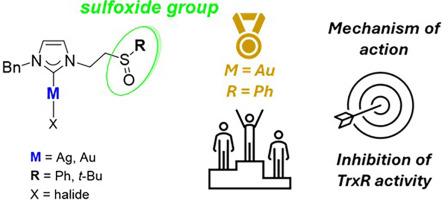Gold(I) complexes with NHC ligands functionalized with sulfoxide groups: Design, synthesis, in vitro studies and insights into the mechanism of action as anticancer drugs
IF 3.2
2区 化学
Q2 BIOCHEMISTRY & MOLECULAR BIOLOGY
引用次数: 0
Abstract
Mononuclear silver(I) complexes of the type [AgBr(NHC)] (NHC=N-heterocyclic carbene) were prepared by reaction of the imidazolium salt NHC·HBr with Ag2O. The corresponding gold(I) complexes [AuCl(NHC)] were isolated by transmetalation reaction from the silver complex to the [AuCl(SMe2)] precursor. The employed NHC ligands are characterized by benzyl and CH2CH2S(O)R (R = Ph or t-Bu) groups as nitrogen wingtip substituents. The antiproliferative activity of the Ag(I) and Au(I) complexes on a panel of different human cancer cell lines is reported. The results show that gold(I) complexes are more active than the analogous silver(I) ones, and between the two gold(I) complexes, the one with R = Ph displays the best results, with IC50 values ranging from 5.4 to 30.6 μM. Mechanistic studies confirm the ability of the reported complexes to hamper Thioredoxin Reductase (TrxR) activity and cellular redox homeostasis, thus leading to oxidative stress induction.

亚砜功能化的NHC配体金(I)配合物:设计、合成、体外研究及抗癌药物作用机制研究
以咪唑盐NHC·HBr与Ag2O反应制备了[AgBr(NHC)]型单核银(I)配合物(NHC= n -杂环碳)。通过银配合物与[AuCl(SMe2)]前驱体的转金属反应分离出相应的金(I)配合物[AuCl(NHC)]。所采用的NHC配体以苯基和CH2CH2S(O)R (R = Ph或t-Bu)基作为氮翼尖取代基。Ag(I)和Au(I)复合物对不同人类癌细胞系的抗增殖活性进行了报道。结果表明,金(I)配合物比类似的银(I)配合物活性更强,其中R = Ph的金(I)配合物效果最好,IC50值在5.4 ~ 30.6 μM之间。机制研究证实了所报道的复合物能够阻碍硫氧还蛋白还原酶(TrxR)活性和细胞氧化还原稳态,从而导致氧化应激诱导。
本文章由计算机程序翻译,如有差异,请以英文原文为准。
求助全文
约1分钟内获得全文
求助全文
来源期刊

Journal of Inorganic Biochemistry
生物-生化与分子生物学
CiteScore
7.00
自引率
10.30%
发文量
336
审稿时长
41 days
期刊介绍:
The Journal of Inorganic Biochemistry is an established international forum for research in all aspects of Biological Inorganic Chemistry. Original papers of a high scientific level are published in the form of Articles (full length papers), Short Communications, Focused Reviews and Bioinorganic Methods. Topics include: the chemistry, structure and function of metalloenzymes; the interaction of inorganic ions and molecules with proteins and nucleic acids; the synthesis and properties of coordination complexes of biological interest including both structural and functional model systems; the function of metal- containing systems in the regulation of gene expression; the role of metals in medicine; the application of spectroscopic methods to determine the structure of metallobiomolecules; the preparation and characterization of metal-based biomaterials; and related systems. The emphasis of the Journal is on the structure and mechanism of action of metallobiomolecules.
 求助内容:
求助内容: 应助结果提醒方式:
应助结果提醒方式:


